The Awa Dance is not just limited to Tokushima Prefecture only, and is performed throughout Japan. Especially Awa Dance Festival of Tokushima City is known as a largest scale in Japan.
The main dance is performed over 4 days during August 12 and 15, but before the dance itself, the "Awa Dance Evening Selection Festival" is held on the 11th. During the event period itself an "Awa Dance Selection" event is held at noon, with the Awa Dance itself being held on stage in the evening, giving visitors plenty of opportunities to enjoy the dance.
The Awa Dance: Japan's Representative Traditional Performance

Tokushima City's "Awa Dance" is the largest in Japan!
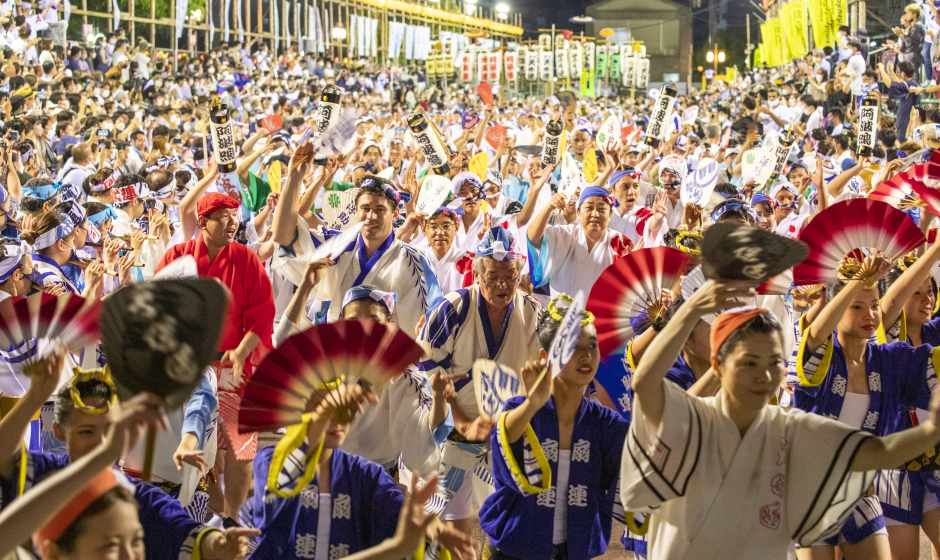
The Awa Odori Kaikan lets visitors enjoy the Awa Dance every day!
The Awa Odori Kaikan is a tourist attraction that gives visitors the opportunity to enjoy the Awa Dance year-round.
The building itself is uniquely shaped like an inverted trapezoid, with a paper lantern motif. Noon performances feature the "Awa-no-kaze" dance troupe, which only performs there. Evening performances feature stage performances by the famous "Yumeiren" with guests able to join in the dancing.
The facility also features an Awa Dance Museum, where visitors can learn about the history of the dance, and "Arudeyo Tokushima" which features a variety of local souvenirs. The Mt. Bizan Ropeway Station is also located in the same building.
Address: 2-20 Shinmachibashi, Tokushima City
Tel: 088-611-1611

The Origins of the Awa Dance
There are 3 theories as to the origins of the Awa Dance.
- The Castle Construction Theory
This theory states that the dance originates from a celebration by local people, performed after the construction of Tokushima Castle, ordered by Hachisuka Iemasa, was completed in 1587.
- The Furyu Dance Theory
The Awa Dance's peculiar trait of being performed by multiple different groups is said to have been influenced by the Furyu dance, said itself to be the origin of Noh plays. In the Miyoshiki record written in 1663, there is evidence that Sogo Nagayasu (also pronounced Masayasu) held a Furyu dance at Shozui Castle in 1578, and this is believed to be the start of the Awa Dance.
- The Bon Dance Theory
The Awa Dance is held in the 7th month of the ancient Japanese unisolar calendar, at the same time as the Bon dance. The Bon Dance is said to have lead to the unique Niwaka and Kumiodori Dances.
Awa Dance Dictionary
A world's first! We are proud to present two albums showcasing the sounds of Awa Odori performed by famous Awa Odori groups.
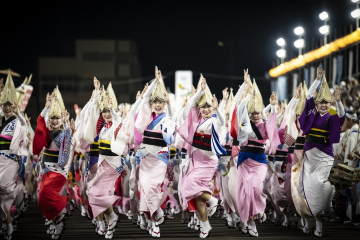
Ren
One of the individual groups of dancers in the Awa Dance.
These groups include both the famous and long-standing Yumeiren, as well as a diversity of other "rens" consisting of company employees and students etc. In total there are more than 1,000 participants in the dance.
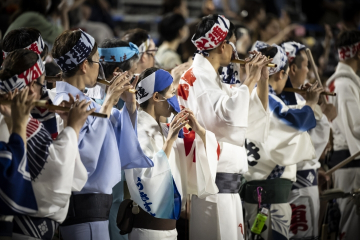
Zomeki
The Awa Dance's cheerful duple time rhythm is known as "zomeki". It also means "boisterous", and implies a dance that is both showy and lively.
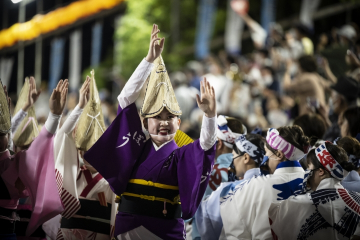
Yoshikono
The song that is sung during the Awa Dance. A popular late-Edo Period folk song, it is said to have originated from the Haiya melody from Ushibuka in Kumamoto, and the Itako melody from Hitachi. Indigo merchants are said to have brought the song to Awa from Kyoto and Osaka.
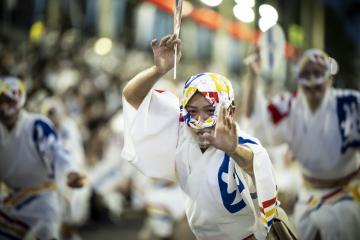
Yattosa
At the start of the dance and throughout, a dancer will yell out "Yattosa!" with the others replying "A, yatto, yatto!". This is believed to have originated from the Nagoya dialect term "Yattokame" which means "It's been a while, how are you?"

Takahari Chochin
At the front of every "ren" are two paper lanterns held on a long bamboo pole. This has the role of regulating the forward speed of the dancers, but is often blown about by the wind, and so requires a lot of strength to hold.
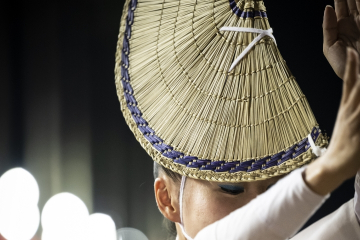
Torioigasa
The hats (kasa) that female dancers wear used to be a variety of shapes, but the Torioigasa became popular from the middle of the Taisho Period (1912 - 1926). Torioigasa literally means "bird scaring hat" and were originally designed to completely hide the wearer's face, while scaring birds from the fields. Pulling the hat down over one's eyes while only partially hiding one's face gives wearers a refined and bewitching look.
